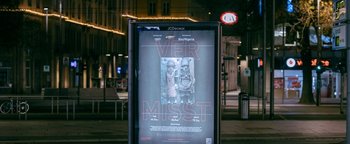Vermisst in Benin: an artistic intervention by Emeka Ogboh
05 January 2021[Translate to English:] Bild Vermisst

[Translate to English:] Vermisst 1
The poster campaign “Vermisst in Benin” (“Missing in Benin”), on display in urban Dresden until 11 January 2021, is an intervention by the artist Emeka Ogboh on the topic of the Benin Bronzes, part of the collection held by Dresden’s Museum für Völkerkunde.
The Benin Bronzes are sculptures from the historical Kingdom of Benin, in what is now Nigeria. At the Benin royal court, the ornate brass castings were a feature of altars commemorating royal ancestors from the past, were used for courtly rituals, or, in the form of brass plates, documented the culture through images. The sculptures tell of Benin’s importance in African history, and of its global connections. The bronzes were looted by British colonial troops at the end of the 19th century during a so-called “punitive expedition” to Benin City, and brought to the UK. In the years that followed, some made their way to the Museum für Völkerkunde in Dresden.
Dresden’s Museum für Völkerkunde belongs to the Staaliche Ehtnographische Sammlungen Sachsen, which has been part of Staatliche Kunstsammlungen Dresden since 2010 and has been researching into the provenance of the items in its care for many years. Based on the time of their acquisition alone, a significant number of these objects are historically related to colonialism. Particular attention needs to be paid to lotted pieces which came into the possession of local museums under German colonial rule, or which were acquired under duress or through the direct use of force by other European colonial powers and entered the State Ethnographic Collections of Saxony at a later point in time. With this in mind, the Benin collection held by the Museum für Völkerkunde Dresden is a particularly controversial set of items. It is part of a large number of Benin bronzes in the possession of European and North American museums.
The five bronzes at the heart of Emeka Ogboh’s artistic intervention arrived at the Dresden museum between 1899 and 1904, bought from the British ethnographic dealer William D. Webster (1868–1913) in London with funding by Arthur Baessler (1857–1907), a well-known Saxon patron of museums. In his work “Vermisst in Benin”, Ogboh addresses the topic of the bronzes’ absence, focusing not only on the story of the looting and theft, but also on the gap thus left in modern Nigeria by these significant relics bearing testimony to cultural heritage.
Emeka Ogboh was born in Enugu, Nigeria in 1977. The sound and installation artist, who has lived in Berlin for six years, uses senses such as sound or taste to establish a relationships with places. His installations explore how private, public or collective memories and stories can be translated into sounds and tastes, and tackle issues around immigration, globalisation and post-colonialism. Ogboh has taken part in numerous international exhibitions including documenta 14 (2017), Skulptur Projekte Münster (2017), the 56th Venice Biennale (2015), and the Dakar Biennale (2014).
Emeka Ogboh: “‘Vermisst in Benin’ is an artistic intervention that seeks to accelerate and actualise the narrative around the reparation of the Benin artefacts currently in possession of the Museum für Völkerkunde Dresden. I created the ‘Vermisst in Benin’ intervention out of a sense of impatience and necessity, aiming to frame the stagnant and abstract discourse surrounding colonial reparations with the urgency and gravity of a public service announcement. The work is a profound approach to a conversation that has simply gone on too long and one which belongs firmly in the public consciousness.”
Léontine Meijer-van Mensch, director of the ethnological museums in Leipzig, Dresden and Herrnhut: “For more than a year, we as museum have been in contact with the Nigerian Embassy in Berlin to discuss possible steps. The embassy has put us in contact with Emeka Ogboh. We are delighted to have brought this internationally famous artist on board to devise and carry out an artistic intervention in urban Dresden. We are grateful that the artist raises this awareness amongst all of us, including the museums and Dresden’s urban community, with his action and for naming so clearly what is at stake with these objects.”
